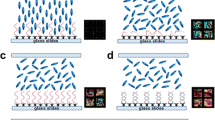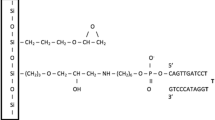Abstract
The surface chemistry and physicochemical phenomena involved in the chemical grafting process of short DNA single strands on silica or glass slides has been studied in order to be able to prepare reusable DNA-arrays (DNA-chips) with an optimum signal-to-noise ratio. Some crucial steps of the immobilisation of oligonucleotides on silica surfaces by means of their chemical grafting at their 3′ terminus (amino-linker) were studied carefully. A prior grafting of the surface with an organosilane is performed. The surface of the silica should have been completely covered by a dense anionic grafted layer in order to minimise DNA adsorption with respect to chemical grafting and allow an easy desorption of non grafted materials. The efficiency of the covalent immobilisation of DNA strands performed from a very dilute solution in a small volume is drastically increased by means of a slow in situ evaporation of the solvent. The discrimination between covalently bound and adsorbed oligonucleotides requires a correct control of the rinsing processes after the immobilisation reaction. An efficient washing process increases the signal-to-noise ratio. Ready hybridisation of complementary oligonucleotides or large double strands bearing the complementary sequence at their centre (PCR fragments) could be obtained at the surface. A clean and robust immobilisation process allows a clear-cut discrimination between hybridisation and non-specific adsorption and very low levels of background (noise) in the radioactivity measurements. Several cycles of hybridisation and denaturation were carried out. Glass plates functionalised according to the same process might be used for the mass preparation of DNA-arrays.
Preview
Unable to display preview. Download preview PDF.
Similar content being viewed by others
Author information
Authors and Affiliations
Corresponding author
Editor information
Rights and permissions
About this paper
Cite this paper
Dugas, V., Chevalier, Y., Depret, G., Nesme, X., Souteyr, É. The immobilisation of DNA strands on silica surface by means of chemical grafting. In: Miguel, M., Burrows, H. (eds) Trends in Colloid and Interface Science XVI. Progress in Colloid and Polymer Science, vol 123. Springer, Berlin, Heidelberg. https://doi.org/10.1007/978-3-540-36462-7_59
Download citation
DOI: https://doi.org/10.1007/978-3-540-36462-7_59
Published:
Publisher Name: Springer, Berlin, Heidelberg
Print ISBN: 978-3-540-00553-7
Online ISBN: 978-3-540-36462-7
eBook Packages: Springer Book Archive




